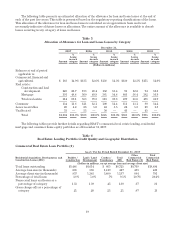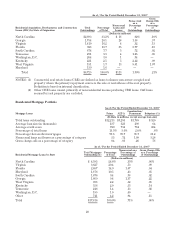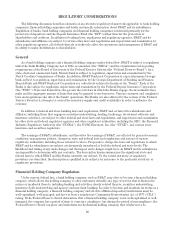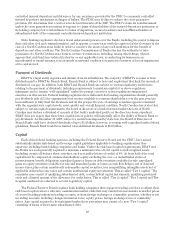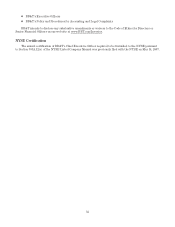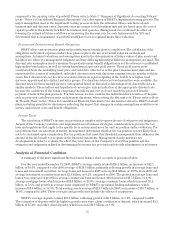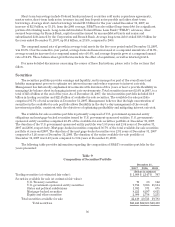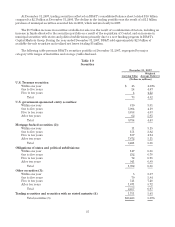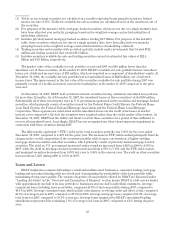BB&T 2007 Annual Report Download - page 29
Download and view the complete annual report
Please find page 29 of the 2007 BB&T annual report below. You can navigate through the pages in the report by either clicking on the pages listed below, or by using the keyword search tool below to find specific information within the annual report.
Each of the federal bank regulatory agencies, including the Federal Reserve Board, also has established
minimum leverage capital requirements for banking organizations. These requirements provide that banking
organizations that meet certain criteria, including excellent asset quality, high liquidity, low interest rate
exposure and good earnings, and that have received the highest regulatory rating must maintain a ratio of Tier 1
capital to total adjusted average assets of at least 3%. Institutions not meeting these criteria, as well as
institutions with supervisory, financial or operational weaknesses, are expected to maintain a minimum Tier 1
capital to total adjusted average assets ratio at least 100 basis points above that stated minimum. Holding
companies experiencing internal growth or making acquisitions are expected to maintain strong capital positions
substantially above the minimum supervisory levels without significant reliance on intangible assets. The Federal
Reserve Board also continues to consider a “tangible Tier 1 capital leverage ratio” (deducting all intangibles) and
other indicators of capital strength in evaluating proposals for expansion or new activity.
In addition, both the Federal Reserve Board and the FDIC have adopted risk-based capital standards that
explicitly identify concentrations of credit risk and the risk arising from non-traditional activities, as well as an
institution’s ability to manage these risks, as important factors to be taken into account by each agency in assessing an
institution’s overall capital adequacy. The capital guidelines also provide that an institution’s exposure to a decline in the
economic value of its capital due to changes in interest rates be considered by the agency as a factor in evaluating a
banking organization’s capital adequacy. The agencies also require banks and bank holding companies to adjust their
regulatory capital to take into consideration the risk associated with certain recourse obligations, direct credit subsidies,
residual interest and other positions in securitized transactions that expose banking organizations to credit risk.
The ratios of Tier 1 capital, total capital to risk-adjusted assets, and leverage capital of BB&T and Branch
Bank as of December 31, 2007, are shown in the following table.
Table 8
Capital Adequacy Ratios of BB&T Corporation and Branch Bank
December 31, 2007
Regulatory
Minimums
Regulatory
Minimums
to be Well-
Capitalized BB&T Branch
Bank
Risk-based capital ratios:
Tier 1 capital (1) 4.0% 6.0% 9.1% 8.8%
Total risk-based capital (2) 8.0 10.0 14.2 11.1
Tier 1 leverage ratio (3) 3.0 5.0 7.2 7.0
(1) Common shareholders’ equity excluding the over-or underfunded status of postretirement benefit
obligations, unrealized gains or losses on debt securities available for sale, unrealized gains on equity
securities available for sale and unrealized gains or losses on cash flow hedges, net of deferred income taxes;
plus certain mandatorily redeemable capital securities, less nonqualifying intangible assets net of applicable
deferred income taxes, and certain nonfinancial equity investments; computed as a ratio of risk-weighted
assets, as defined in the risk-based capital guidelines.
(2) The sum of Tier 1 capital, a qualifying portion of the allowance for credit losses, qualifying subordinated debt
and qualifying unrealized gains on available for sale equity securities; computed as a ratio of risk-weighted
assets, as defined in the risk-based capital guidelines.
(3) Tier 1 capital computed as a percentage of fourth quarter average assets less nonqualifying intangibles and
certain nonfinancial equity investments.
The federal banking agencies, including the Federal Reserve Board and the FDIC, are required to take
“prompt corrective action” in respect of depository institutions and their bank holding companies that do not
meet minimum capital requirements. The law establishes five capital categories for insured depository
institutions for this purpose: “well-capitalized,” “adequately capitalized,” “undercapitalized,” “significantly
undercapitalized” and “critically undercapitalized.” To be considered “well-capitalized” under these standards, an
institution must maintain a total risk-based capital ratio of 10% or greater; a Tier 1 risk-based capital ratio of 6%
or greater; a leverage capital ratio of 5% or greater; and must not be subject to any order or written directive to
meet and maintain a specific capital level for any capital measure. BB&T and Branch Bank are classified as “well-
29


